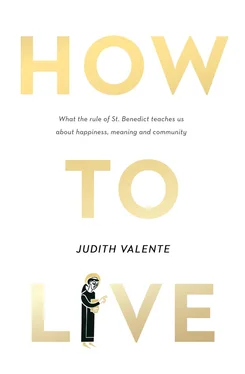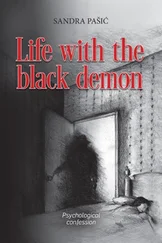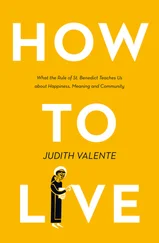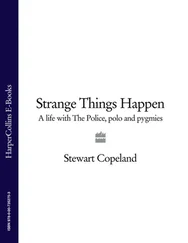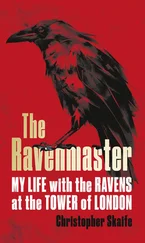—FROM THE PROLOGUE
To delve deeply into The Rule is to discover just how astutely Benedict was writing in the 6th century. Recent discoveries about how the brain works buttress ideas he espoused before neuroscience was even a word. Paul Zak is an economist and brain researcher who has studied the effect on the human psyche of a powerful hormone called oxytocin. This is the chemical released in lovemaking, in women who have just given birth, as well as in people who have just acted in some way that benefits others. Zak calls oxytocin “the morale molecule.”
Using a variety of research experiments, Zak found that those who give usually end up receiving in return. One person’s generosity can even increase the oxytocin levels in another. In other words, human beings appear hardwired for community. We prosper most when we extend trust and receive it in return. The economic models we learn in MBA programs would have us believe the opposite—that self-interest is the fundamental human motivator. Zak, by contrast, found that trusting and exhibiting generous behavior leads to reciprocal generosity and trust.
“The most important factor in determining whether or not a society does well or is impoverished,” Zak concluded, “is not natural resources, education, quality health care, or even the work ethic of its people. What matters most in determining outcomes is actually trustworthiness—a moral consideration.”
This sounds a good deal like the community Benedict sought to create, and the one he entrusts us to build today. He foresaw the dangers of radical self-interest of the kind that led to the economic meltdown of 2008 and to the Great Depression (as well as other economic crises before and since then), to practices like slavery and apartheid, and to so many of the world’s wars. No one is to pursue what he judges better for himself to the detriment of others. This Benedict counseled nearly two millennia before oxytocin was even discovered.
The Rule also has a message for those of us on call twenty-four seven, swirling in a maelstrom of email, texting, Twitter, and Snapchat. It beckons as a plea for balance. Benedict carved the monastic day into distinct periods for work, prayer, reading, leisure, and rest. He believed there is a time to work, and a time to stop work. As someone who has long suffered from a dual diagnosis of workaholic and overachieverism, The Rule showed me that it is possible to pause, to care for myself, and still be productive. With its focus on balance, The Rule helps orient my attention toward the sacred in the ordinary. It propels me to live every day.
In many ways, Benedict and his predecessors—the early monastics of the Egyptian desert—were among history’s first psychologists. They understood that in order to live in community—or even as hermits—they would have to confront the emotional demons that haunt us all. They discovered ways to leaven our natural tendencies toward anger, self-absorption, greed, depression, unhealthy appetites, and obsessions. They did this not by repressing those tendencies, but by recognizing we are not our thoughts and we are not our feelings. We can redirect our thoughts and feelings into constructive actions. Doing this allows us to confront life’s inevitable turbulence with equanimity. The emotional tools that The Rule lays out have been more valuable to me than any self-help book or therapy session.
The reflections in the pages that follow are my attempts to draw out the major themes of The Rule in practical takeaways that can lead to personal transformation. For many centuries, men and women who entered monasteries were expected to memorize The Rule in the same way they committed to memory the Psalms or traditional prayers. But as the Benedictine writer Mary Margaret Funk points out, The Rule is not something to be absorbed intellectually. It has to be lived. It has to take up residence in our inner life.
“Benedict’s great insight,” she writes in her memoir Out of the Depths, “was that the work of the monastery was not simply about men and women living apart from society in a community. The true work lay in how one developed the interior life.”
The happy news is that this also applies to people who don’t live in monasteries—people like you and me who are trying to nurture a family, succeed in a rapidly changing workplace, and grow old with a sense of purpose. The true monastic enclosure is the human heart.
While there is still time, while we are in this body and have time to accomplish all these things, let us run and do now what will profit us forever.
—FROM THE PROLOGUE
Happily too, St. Benedict promises to demand of us nothing harsh, nothing burdensome. He reminds us we are always only beginners on the path to a deeper interior life. The spiritual journey is not a flight on a supersonic jet, but a slow steady trek, like hiking the Appalachian Trail or walking El Camino de Santiago de Compostela. “The spiritual life is this,” a monastic elder from the Egyptian desert once said, “I rise and I fall. I rise and I fall.”
I used to think of monastic life as a hopeless throwback to the past, a case of let the last monk or sister standing turn out the lights. Now I look upon it as a window to the future we desperately need in our society: one that stresses community over competition, consensus over conflict, simplicity over self-gain, and silence over the constant chatter and distractions of our lives. And so we begin.
Is there anyone here who yearns for life and desires to see good days?
Конец ознакомительного фрагмента.
Текст предоставлен ООО «ЛитРес».
Прочитайте эту книгу целиком, купив полную легальную версию на ЛитРес.
Безопасно оплатить книгу можно банковской картой Visa, MasterCard, Maestro, со счета мобильного телефона, с платежного терминала, в салоне МТС или Связной, через PayPal, WebMoney, Яндекс.Деньги, QIWI Кошелек, бонусными картами или другим удобным Вам способом.
